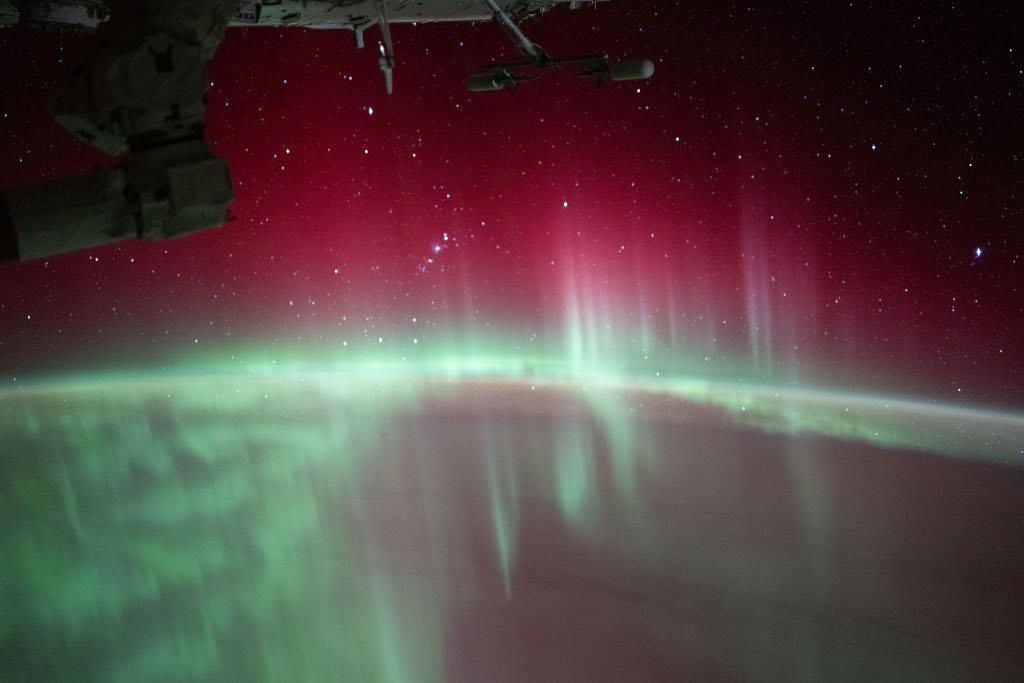13. September 2024
南極光 kah 國際太空站

探索宇宙1!逐工會揀一幅無仝款 ê 影像抑是相片,𤆬你熟似咱這个迷人 ê 宇宙,閣有專業天文學者2為你3解說4。
- 原始文章:Aurora Australis and the International Space Station
- 影像來源:NASA, ISS Expedition 71
- 攑頭看:International Observe the Moon Night
- 台文翻譯:An-Li Tsai (NSYSU)
[漢羅] 南極光 kah 國際太空站
這張速翕 是 8 月 11 tī 國際太空站 翕--ê。 這个時陣,太空站是飛 tī 地球 南半球 印度洋 頂懸 430 公里懸 ê 所在。 這个壯觀 ê 景色是向南爿 kah 東爿看過去 ê 景色,上下底是地球 ê 地平線,中央經過 紅色 kah 青色 ê 南極光 窗仔布。 國際太空站 ê 軌道懸,差不多就是 高層大氣 ê 懸度。 極光是 薄縭絲 ê 高層大氣 內底 ê 激發態 酸素原子 發出 ê 輻射。 青色發射線 主要是 海拔 100 到 250 公里懸 ê 酸素原子輻射。 毋過紅色發射線 是 酸素原子輻射 一直到 海拔 500 公里懸 攏有。 這个低地球軌道 ê 景色,除了南極光,嘛有翕著 南半球 ê 星空。 獵戶座皮帶 kah 獵戶座星雲 就出現 tī 地球 邊界頂懸,就相片中央倚倒爿遐。 天狼星是 大犬座 ê alpha 星,是 地球暗暝天頂 上光 ê 恆星。 伊就出現 tī 太空站 下底 ê 南半球夜空,tī 相片正爿中央遐。
[POJ] Lâm-ke̍k-kng kah Kok-chè Thài-khong-chām
Chit-tiuⁿ sok-hip sī 8 goe̍h 11 tī Kok-chè thài-khong-chām hip--ê. Chit-ê sî-chūn, thài-khong-chām sī poe tī Tē-kiû lâm-pòaⁿ-kiû Ìn-tō͘-iûⁿ téng-koân 430 kong-lí koân ê só͘-chāi. Chit-ê chòng-koan ê kéng-sek sī hiòng lâm-pêng kah tang-pêng khòaⁿ--kòe-khì ê kéng-sek, siōng ē-té sī Tē-kiû ê tē-pêng-sòaⁿ, tiong-ng keng-kòe âng-sek kah chhiⁿ-sek ê lâm-ke̍k-kng thang-á-pò͘. Kok-chè Thài-khong-chām ê kúi-tō koân, chha-put-to tio̍h-sī ko-chân tāi-khì ê koân-tō͘. Ke̍k-kng sī po̍h-li-si ê ko-chân tāi-khì lāi-té ê kek-hoat-thài sàng-sò͘ goân-chú hoat--chhut ê hok-siā. Chhiⁿ-sek hoat-siā-sòaⁿ chú-iàu sī hái-poa̍t 100 kàu 250 kong-lí koân ê sàng-sò͘ goân-chú hok-siā. M̄-koh âng-sek hoat-siā-sòaⁿ sī sàng-sò͘ goân-chú hok-siā it-ti̍t kàu hái-poa̍t 500 kong-lí koân lóng-ū. Chit-ê kē Tē-kiû kúi-tō ê kéng-sek, tû-liáu lâm-ke̍k-kng, mā ū hip-tio̍h lâm-pòaⁿ-kiû ê seng-khong. La̍h-hō͘-chō Phôe-tòa kah La̍h-hō͘-chō Seng-hûn tō chhut-hiān tī Tē-kiû pian-kài téng-koân, to̍h siòng-phìⁿ tiong-ng óa tò-pêng hia. Thian-lông-chhiⁿ sī Tōa-khián-chō ê alpha chhiⁿ, sī Tē-kiû àm-mê thiⁿ-téng siōng kng ê hêng-chhiⁿ. I to̍h chhut-hiān tī Thài-khong-chām ē-té ê lâm-pòaⁿ-kiû iā-khong, tī siòng-phìⁿ chiàⁿ-pêng tiong-ng hia.
[KIP] Lâm-ki̍k-kng kah Kok-tsè Thài-khong-tsām
Tsit-tiunn sok-hip sī 8 gue̍h 11 tī Kok-tsè thài-khong-tsām hip--ê. Tsit-ê sî-tsūn, thài-khong-tsām sī pue tī Tē-kiû lâm-puànn-kiû Ìn-tōo-iûnn tíng-kuân 430 kong-lí kuân ê sóo-tsāi. Tsit-ê tsòng-kuan ê kíng-sik sī hiòng lâm-pîng kah tang-pîng khuànn--kuè-khì ê kíng-sik, siōng ē-té sī Tē-kiû ê tē-pîng-suànn, tiong-ng king-kuè âng-sik kah tshinn-sik ê lâm-ki̍k-kng thang-á-pòo. Kok-tsè Thài-khong-tsām ê kuí-tō kuân, tsha-put-to tio̍h-sī ko-tsân tāi-khì ê kuân-tōo. Ki̍k-kng sī po̍h-li-si ê ko-tsân tāi-khì lāi-té ê kik-huat-thài sàng-sòo guân-tsú huat--tshut ê hok-siā. Tshinn-sik huat-siā-suànn tsú-iàu sī hái-pua̍t 100 kàu 250 kong-lí kuân ê sàng-sòo guân-tsú hok-siā. M̄-koh âng-sik huat-siā-suànn sī sàng-sòo guân-tsú hok-siā it-ti̍t kàu hái-pua̍t 500 kong-lí kuân lóng-ū. Tsit-ê kē Tē-kiû kuí-tō ê kíng-sik, tû-liáu lâm-ki̍k-kng, mā ū hip-tio̍h lâm-puànn-kiû ê sing-khong. La̍h-hōo-tsō Phuê-tuà kah La̍h-hōo-tsō Sing-hûn tō tshut-hiān tī Tē-kiû pian-kài tíng-kuân, to̍h siòng-phìnn tiong-ng uá tò-pîng hia. Thian-lông-tshinn sī Tuā-khián-tsō ê alpha tshinn, sī Tē-kiû àm-mê thinn-tíng siōng kng ê hîng-tshinn. I to̍h tshut-hiān tī Thài-khong-tsām ē-té ê lâm-puànn-kiû iā-khong, tī siòng-phìnn tsiànn-pîng tiong-ng hia.
[English] Aurora Australis and the International Space Station
This snapshot from the International Space Station was taken on August 11 while orbiting about 430 kilometers above the Indian Ocean, Southern Hemisphere, planet Earth. The spectacular view looks south and east, down toward the planet's horizon and through red and green curtains of aurora australis. The auroral glow is caused by emission from excited oxygen atoms in the extremely rarefied upper atmosphere still present at the level of the orbiting outpost. Green emission from atomic oxygen dominates this scene at altitudes of 100 to 250 kilometers, while red emission from atomic oxygen can extend as high as 500 kilometers altitude. Beyond the glow of these southern lights, this view from low Earth orbit reveals the starry sky from a southern hemisphere perspective. Stars in Orion's belt and the Orion Nebula are near the Earth's limb just left of center. Sirius, alpha star of Canis Major and brightest star in planet Earth's night is above center along the right edge of the southern orbital skyscape.
詞彙學習
| 漢羅 | POJ | KIP | 華語 | English |
|---|---|---|---|---|
| 南極光 | lâm-ke̍k-kng | lâm-ki̍k-kng | 南極光 | aurora australis |
| 國際太空站 | Kok-chè-thài-khong-chām | Kok-tsè-thài-khong-tsām | 國際太空站 | International Space Station (ISS) |
| 速翕 | sok-hip | sok-hip | 快照 | snapshot |
| 窗仔布 | thang-á-pò͘ | thang-á-pòo | 窗簾 | curtain |
| 高層大氣 | ko-chân-tāi-khì | ko-tsân-tāi-khì | 高層大氣lo | upper-atmosphere |
| 激發態 | kek-hoat-thài | kik-huat-thài | 激發態 | excited state |
| 酸素 | sàng-sò͘ | sàng-sòo | 氧 | oxygen |
| 海拔 | hái-poa̍t | hái-pua̍t | 海拔 | altitudes |
| 獵戶座皮帶 | La̍h-hō͘-chō Phôe-tòa | La̍h-hōo-tsō Phuê-tuà | 獵戶座腰帶 | Orion's belt |
| 獵戶座星雲 | La̍h-hō͘-chō Seng-hûn | La̍h-hō͘-tsō Sing-hûn | 獵戶座星雲 | Orion Nebula |
| 天狼星 | Thian-lông-chhiⁿ | Thian-lông-tshinn | 天狼星 | Sirius |
| 大犬座 alpha 星 | Tāi-khián-chō alpha chhiⁿ | Tāi-khián-tsō alpha tshinn | 大犬座 alpha | alpha Canis Major |
| 南半球 | lâm-pòaⁿ-kiû | lâm-puànn-kiû | 南半球 | southern hemisphere |